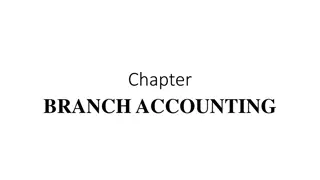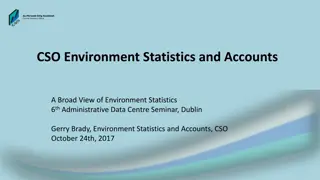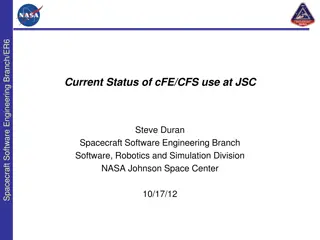
Branch Accounts for Effective Financial Management
Branch accounts play a crucial role in recording and analyzing financial transactions of different branches within a business. They help evaluate profitability, performance, and areas for improvement. Learn about the purpose, structure, maintenance methods, key components, inter-branch transactions, and challenges in branch accounting.
Download Presentation

Please find below an Image/Link to download the presentation.
The content on the website is provided AS IS for your information and personal use only. It may not be sold, licensed, or shared on other websites without obtaining consent from the author. If you encounter any issues during the download, it is possible that the publisher has removed the file from their server.
You are allowed to download the files provided on this website for personal or commercial use, subject to the condition that they are used lawfully. All files are the property of their respective owners.
The content on the website is provided AS IS for your information and personal use only. It may not be sold, licensed, or shared on other websites without obtaining consent from the author.
E N D
Presentation Transcript
Introduction to Branch Accounts Branch accounts are used to record the financial transactions of different branches of a branches of a business. They help in determining the profitability and performance of each branch separately. Understanding branch accounts is crucial for effective financial management and decision- making.
Purpose of Branch Accounts The primary purpose of branch accounts is to is to provide insights into each branch's financial health. They facilitate the evaluation of branch performance against budgets and forecasts. Branch accounts also assist in identifying areas for improvement and strategic growth.
Structure of Branch Accounts Branch accounts typically include a branch branch profit and loss account and a branch branch balance sheet. The profit and loss account summarizes the revenues and expenses of the branch. The balance sheet provides a snapshot of the branch s assets, liabilities, and equity at a specific point in time.
Methods of Maintaining Branch Accounts There are two primary methods: the Debtors and Creditors Method and the Independent Branch Method. The Debtors and Creditors Method records transactions in the main account while maintaining a separate branch account. The Independent Branch Method treats branch accounts as standalone entities, providing complete financial records for each branch.
Key Components of Branch Accounts Revenue generated by the branch, including sales and other income, is a key component. Direct and indirect expenses incurred by the branch are also recorded to assess profitability. Assets and liabilities specific to the branch must be tracked to maintain accurate financial reporting.
Inter-Branch Transactions Inter-branch transactions occur when goods or services are exchanged between branches. These transactions must be accurately recorded to ensure proper accounting and financial integrity. It is essential to establish clear policies for pricing and recording inter-branch transactions.
Challenges in Branch Accounting One major challenge is ensuring consistency in accounting practices across different branches. Currency differences and local regulations can complicate the financial reporting process. Another challenge is timely communication and data sharing between branches and the head office.
Benefits of Using Branch Accounts Branch accounts provide detailed insights into the operations and profitability of each branch. They enhance accountability and responsibility among branch managers for their financial performance. Using branch accounts can lead to better resource allocation and strategic planning.
Technology and Branch Accounts Advanced accounting software can streamline the management of branch accounts. Automation reduces the risk of errors and enhances the efficiency of financial reporting processes. Cloud-based systems allow real-time access to financial data across all branches, improving decision-making.
Conclusion Branch accounts are essential for effective financial management in multi-branch organizations. They provide valuable insights that contribute to strategic planning and operational efficiency. Understanding and implementing robust branch accounting practices can drive business success. Feel free to adjust or expand on any points as needed!






















